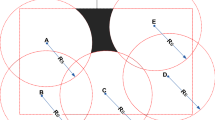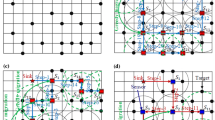Abstract
Coverage of the bounded region gets importance in Wireless Sensor Network (WSN). Area coverage is based on effective surface coverage with a minimum number of sensor nodes. Most of the researchers contemplate the coverage region of interest as a square and manifest the radio ranges as a circle. The area of a circle is much higher than the area of a square because of the perimeter. To utilize the advantage of the circle, the coverage region of interest is presumed as a circle for sensor node deployment. This paper proposes a novel coverage improved disc shape deployment strategy. Comparative analysis has been observed between circle and square regions of interest based on the cumulative number of sensor nodes required to cover the entire region. A new strategy named as disc shape deployment strategy is also proposed. Traditional hexagon and strip-based deployment strategies are compared with the disc shape deployment strategy. The simulation result shows that the circle shape coverage region of interest extremely reduces the required number of sensor nodes. The proposed deployment strategy provides desirable coverage, and it requires few more sensor nodes than hexagon shape deployment strategy.















Similar content being viewed by others
References
Akyildiz, I. F., Su, W., Sankarasubramaniam, Y., & Cayirci, E. (2002). A survey on sensor network. IEEE Communication Magazine, 40(8), 102–114.
Biagioni, ES. & Sasaki, G. (2003). Wireless sensor placement for reliable and efficient data collection. In: Proceedings of the 36th Annual Hawaii International Conference on System Sciences. Big island, USA.
NicolasGeorganas, T. D. D. (2004). Connectivity Mintenance and coverage preservation in wireless sensor networks. Canadian Conference on Electrical and Computer Engineering., 3(6), 744–761.
Ahmed, N., Kanhere, S.S. & Jha, S. (2005). Probabilistic coverage in wireless sensor networks. In: IEEE Conference on Local Computer Networks 30th Anniversary (LCN’05). Sidney, Australia.
Chang, R. S., & Wang, S. H. (2008). Self-deployment by density control in sensor networks. IEEE Transactions on Vehicular Technology., 57(3), 1745–1755.
Wang, Y. C., Hu, C. C., & Tseng, Y. C. (2008). Efficient placement and dispatch of sensors in a wireless sensor network. IEEE Transaction on Mobile Computing., 7(2), 262–274.
Chatterjee, P., Ghosh, S. C., & Das, N. (2017). Load balanced coverage with graded node deployment in wireless sensor networks. IEEE Transaction on Multi-Scale Computing Systems., 3(2), 100–112.
Li, X., Frey, H., Santora, N. & Stojmenovic, I. (2009). Focused-coverage by mobile Sensor Networks. Mobile Ad hoc and Sensor Systems. In: IEEE 6th International Conference on mobile Adhoc and Sensor System. Macau, China.
Wang, Y. C., & Tseng, Y. C. (2007). Distributed deployment schemes for mobile wireless sensor networks to ensure multilevel coverage. IEEE Transaction on Parallel Distributed System., 19(9), 1280–1294.
Bai, X., Kumar, S., Xuan, D., Yun, Z. & Lai, T.H. (2006). Deploying wireless sensors to achieve both coverage and connectivity. In: Proceedings of the 7th ACM International Symposium on Mobile Ad Hoc Networking and Computing. Florence, Italy.
Yu, Z., Teng, J., Li, X. & Xuan, D. (2013). On wireless network coverage in bounded areas. In: Proceedings IEEE Infocom. Turin, Italy.
Al-Turjman, F. (2018). Wireless Sensor Networks: Deployment Strategies for Outdoor Monitoring, CRC Press
Habib M. Ammari, Mission-Oriented Sensor Networks and Systems: Art and Science, Springer Nature, 2019, Volume 1
Zhang, Y., Xue, D., Wu, C., Peng J.I. & Cheng, L. (2009). Research of nodes deployment for wireless sensor network in determinstic area. In: Computer Science and Information Technology, ICCSIT 2009, 2nd IEEE International Conference. Beijing, China.
Ku, W. S., Sakai, K., & Sun, M. T. (2011). The optimal k-covering tag deployment for RFID based localization. Journal of Network and Computer Applications., 34(3), 914–924.
Yun, Z., Bai, X., Xuan, D., Jia, W. & Zhao, W. (2010). Pattern mutation in wireless sensor deployment. Proceedings IEEE Infocom. San Diago, USA.
Lu, X., Chen, R., Liu, J. & Cheng, L. (2018) Square partition‐based node scheduling algorithm for wireless passive sensor networks, International Journal of Communication Systems, 31(8), e3531
(2008). Sensing coverage for randomly distributed wireless sensor networks in shadowed environments, IEEE Transactions on Vehicular Technology.
(2015). Experimental analysis of some radio propagation models for smart wireless sensor networks applications, IEEE CONFerence on. Sai Intellisys
(2016). Radio range mapping in wireless sensor networks. In: IEEE Conference on. HMI.
(2019). Linear wireless sensor networks for cathodic protection monitoring of pipelines. In: IEEE Conference on MORSE.
(2019) RSS-based coverage deployment method under probability model in 3D-WSN, IEEE Access.
(2020). Optimal operation mode selection for energy-efficient light-weight multi-hop time synchronization in linear wireless sensor networks, EURASIP Journal on Wireless Communications and Networking.
(2020). Linear Wireless sensor networks energy minimization using optimal placement strategies of nodes, Wireless Personal Communications.
Zhang, H & Hou, J.C. 2005. Maintaining sensing coverage and connectivity in large sensor networks. Adhoc Sensor Wireless Network 1(2), 89–124.
Wang, Y.C., Hu, C.C. & Tseng, Y.C. 2005. Efficient deployment algorithms for ensuring coverage and connectivity of wireless sensor networks. In: First International Conference on Wireless Internet (WICON’05). Budapest, Hangary.
Author information
Authors and Affiliations
Corresponding author
Ethics declarations
Conflict of interest
On behalf of all authors, the corresponding author states that there is no conflict of interest.
Data Availability
Data sharing not applicable to this article as no datasets were generated or analysed during the current study.
Additional information
Publisher's Note
Springer Nature remains neutral with regard to jurisdictional claims in published maps and institutional affiliations.
Rights and permissions
About this article
Cite this article
Paulswamy, S.L., Roobert, A.A. & Hariharan, K. A Novel Coverage Improved Deployment Strategy for Wireless Sensor Network. Wireless Pers Commun 124, 867–891 (2022). https://doi.org/10.1007/s11277-021-09387-y
Accepted:
Published:
Issue Date:
DOI: https://doi.org/10.1007/s11277-021-09387-y




